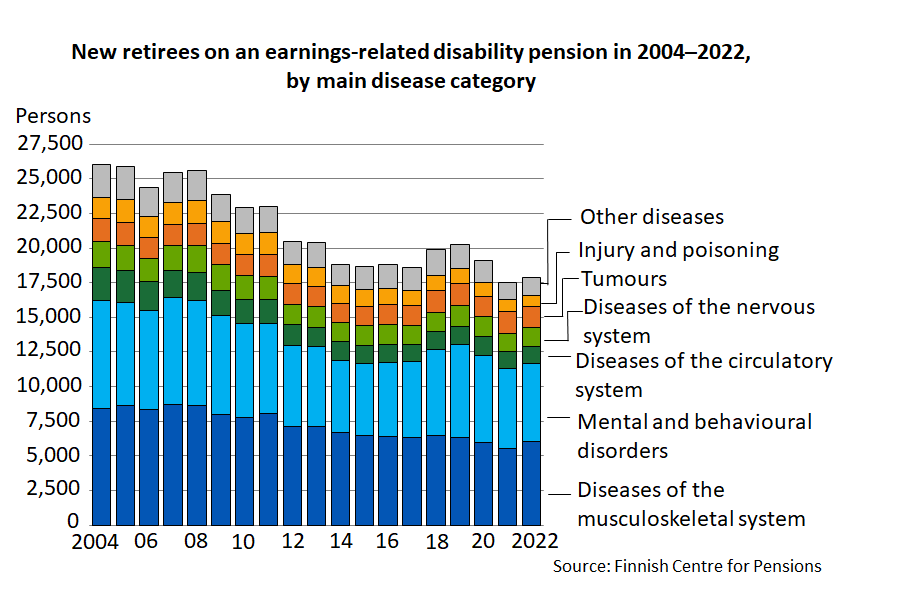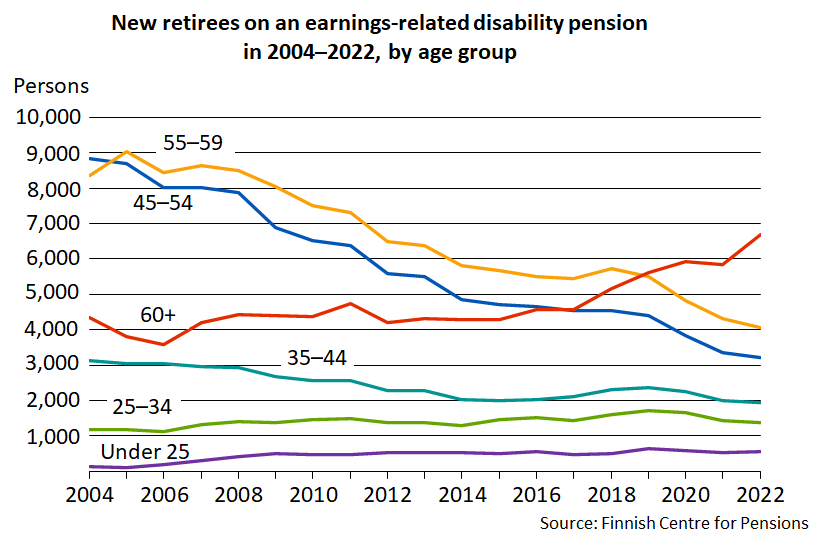Musculoskeletal diseases the main cause of retirement on a disability pension in 2022

The number of new disability pensions granted due to musculoskeletal diseases grew by nearly 10 per cent in 2022. A growing share of new pensioners on a disability pension are 60 years or over.
The number of new Finnish pensioners on a disability pension increased slightly last year after a downward trend during the corona pandemic. In 2022, nearly 17,900 persons retired on a disability pension, up by around two per cent compared to 2021. This information stems from new statistics released by the Finnish Centre for Pensions.
“Musculoskeletal diseases underly this change. The number of new disability pensions granted based on them grew by nearly 10 per cent compared to 2021”, says Statistics Planner Joonas Hautamäki (Finnish Centre for Pensions).
Due to this growth, musculoskeletal diseases became once again the most common main disease category for retirement on a disability pension. Last time this happened was in 2018.

Growing share of older people among new pensioners on a disability pension
Looking at the big picture, the main disease category is not the only element that has changed regarding Finnish disability pensioners. The age structure has also become different. A growing share of new pensioners on a disability pension are aged 60 or over. In 2017, only around one quarter of new disability pensions were granted to persons who had turned 60. In 2022, the same was true for more than one third of new granted disability pensions. In 2022, nearly 6,700 new pensioners on a disability pension had turned 60. Half of them retired due to musculoskeletal diseases.

The causes for retirement on a disability pension are strongly linked to age. For those under the age of 55, the main cause for disability is mental and behavioural disorders. Persons older than that most often retire on a disability pension due to musculoskeletal diseases.
“Although the employment rate of older persons has soared in the 2000s, some lack the ability to work until retirement. As the retirement age continues to rise in future years, we have to pay increasing attention to how those in their 60s cope at work”, says Statistics Manager Tiina-Palotie-Heino.
Mental disorders lead less often to retirement on a disability pension in Finland
As in a few previous years, the number of new disability pensions due to mental and behavioural disorders went down in 2022. That said, mental disorders continue to play a considerable role in disability. The second highest number of new disability pensions due to mental and behavioural disorders – more than 5,600 – were granted in 2022.
Depression continues to be the most common mental disorder leading to retirement on a disability pension. In 2022, considerably more women than men retired on a disability pension due to depression: 2,100 women vs. 1,000 men.
A continued downward trend in granted disability pensions due to mental disorders was not expected.
“There was a risk that the end of the pandemic would lead to a growing number of unemployed persons. Some of the workers in poor condition probably hung in there while working remotely during the years of the pandemic, waiting for the moment they would dare to go out and see a doctor. Fortunately, it seems that unloading health care queues has not led to an increase in the number of disability pensions, at least not so far”, Palotie-Heino explains.
At year-end 2022, a total of 120,000 persons drew an earnings-related disability pension. This was around 4,500 fewer than in 2021. Nearly every third disability pension was granted as a partial pension in 2022.
More information
Earnings-related pension recipients in Finland (OSF) (Etk.fi statistical website)
Image: Vesa Laitinen

